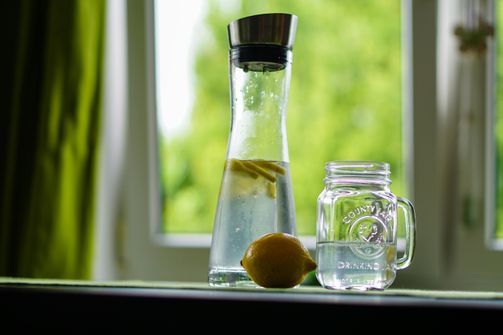
Separating Fact from Fiction: Do Detox Drinks Really Work?
Detox beverages have gained massive popularity in recent years, with promises of everything from quick weight loss to complete bodily "cleansing." Fro...

When it comes to maintaining a healthy diet, women have unique nutritional needs that evolve throughout different stages of life. Whether you’re balancing work, family, or your personal health goals, finding a diet that provides the right nutrients without feeling restrictive can be a challenge.
Enter the Harvard Plate—a science-backed guide to balanced eating that’s practical, easy to follow, and specifically beneficial for women.
Let’s explore how the Harvard Plate can help women achieve optimal health, supported by facts, numbers, and stats.

The Harvard Plate, also known as the Harvard Healthy Eating Plate, was developed by nutrition experts at the Harvard T.H. Chan School of Public Health. Unlike many diet plans that are hard to stick with, the Harvard Plate is a visual guide designed to make healthy eating simple and sustainable. It emphasizes balanced meals with the right proportions of vegetables, fruits, whole grains, and healthy proteins.
Here’s how the Harvard Plate breaks down:
By focusing on these components, the Harvard Plate helps women create balanced, nutrient-dense meals that support long-term health.
Women’s hormonal health is crucial at every stage of life, whether it’s managing PMS, pregnancy, or menopause. The Harvard Plate encourages a diet rich in vegetables, fruits, and Healthy Fats—nutrients essential for maintaining hormonal balance.
Healthy fats like those found in avocados, olive oil, and fatty fish are vital for hormone production. For example, omega-3 fatty acids help regulate estrogen and progesterone levels, which can reduce symptoms of PMS and menopause. In fact, studies show that women who consume omega-3-rich diets experience 25% fewer menstrual cramps and mood swings than those who don’t.
As women age, metabolism tends to slow down, making weight management more challenging. The Harvard Plate’s focus on whole grains, lean proteins, and plenty of vegetables can help maintain a healthy weight while ensuring you don’t feel deprived.
Women are at a higher risk of developing osteoporosis, especially after menopause, when bone density decreases rapidly. The Harvard Plate’s emphasis on including calcium-rich foods, such as leafy greens and fortified plant-based milks, helps support strong bones.
FDA notes that 80% of the 10 million Americans with osteoporosis are women. Incorporating adequate calcium and vitamin D into your diet can reduce the risk of fractures by up to 50%.
Heart disease is the leading cause of death among women in the United States, making heart health a critical focus. The Harvard Plate’s recommendation to include healthy fats, lean proteins, and plenty of vegetables aligns perfectly with heart-healthy eating.
Vascular Health and Risk Management highlights that women who follow a diet rich in vegetables, fruits, whole grains, and healthy fats can reduce their risk of heart disease by up to 30%.
Good digestive health is vital for overall well-being, yet it’s often overlooked. The Harvard Plate’s focus on fiber-rich vegetables, fruits, and whole grains can help women maintain a healthy digestive system.
Women who consume enough fiber are 25% less likely to suffer from digestive issues like constipation and irritable bowel syndrome (IBS), according to data from the Nutrients.
One of the best aspects of the Harvard Plate is its simplicity, making meal planning easy and effective. Here’s how you can build your meals:
Healthy snacks are an essential part of the Harvard Plate approach. Keep nutritious options like a handful of nuts, fresh fruit, or whole-grain crackers with hummus on hand. These snacks align with the Harvard Plate’s principles and help curb hunger between meals.
Cooking with healthy fats is simple and beneficial. Use olive oil or avocado oil when preparing your meals. These fats not only add flavor but also support heart health.
Proper hydration is key to health, and the Harvard Plate encourages it. Drink plenty of water throughout the day. If plain water isn’t appealing, try herbal teas or flavored water with a splash of lemon or cucumber to stay refreshed.
The Harvard Plate is more than just a diet guide—it’s a practical tool that helps women address specific health concerns, from hormonal balance and weight management to bone health and heart disease prevention. By focusing on balanced meals that include a variety of vegetables, fruits, whole grains, and lean proteins, women can achieve optimal health at every stage of life.
Whether you’re navigating the challenges of menopause, looking to boost your energy levels, or simply trying to maintain a healthy weight, the Harvard Plate offers a flexible and sustainable approach to nutrition. Start incorporating its principles into your daily meals, and you’ll be on your way to a healthier, more balanced life.
A: The Harvard Plate is unique because it provides a visual guide for balanced eating that’s easy to follow. Unlike the USDA MyPlate, which focuses on portions, the Harvard Plate emphasizes the quality of the foods you choose, such as whole grains over refined grains and healthy fats over unhealthy ones. It’s designed to be flexible, accommodating various dietary preferences while ensuring that you get the necessary nutrients to support overall health.
A: The Harvard Plate supports weight management by focusing on nutrient-dense foods that keep you full longer, such as whole grains, lean proteins, and fiber-rich vegetables. By avoiding processed foods and sugary drinks, it helps regulate blood sugar levels and prevent overeating. Studies show that diets rich in these foods are associated with better weight control over time.
A: Yes, the Harvard Plate can easily be adapted for specific health concerns. For heart health, it emphasizes healthy fats, such as those found in olive oil and nuts, and encourages the consumption of whole grains and vegetables that help lower cholesterol. For osteoporosis, the plate promotes calcium-rich foods like leafy greens and fortified plant milks, as well as vitamin D sources to support bone health.
A: Absolutely. The Harvard Plate is versatile and can be tailored to fit vegetarian and vegan diets. For protein, vegetarians can opt for beans, tofu, nuts, and dairy, while vegans can choose plant-based proteins like legumes, quinoa, and nuts. The emphasis on whole grains, vegetables, and fruits remains the same, making it a balanced choice for those on plant-based diets.
A: The Harvard Plate supports hormonal health by encouraging the consumption of healthy fats, which are essential for hormone production. Foods like avocados, olive oil, and fatty fish are rich in omega-3 fatty acids, which help regulate hormones like estrogen and progesterone. This can lead to fewer PMS symptoms and a smoother transition during menopause.
A: To incorporate the Harvard Plate into your daily routine, start by filling half your plate with vegetables and fruits, choosing a variety of colors to ensure you get a range of nutrients. Add a quarter of whole grains, like brown rice or quinoa, and complete the plate with a quarter of lean protein, such as grilled chicken or tofu. Use healthy fats like olive oil for cooking, and make sure to stay hydrated with water or herbal teas throughout the day.

Detox beverages have gained massive popularity in recent years, with promises of everything from quick weight loss to complete bodily "cleansing." Fro...

Staying hydrated is essential for your overall health, but plain water can get a little boring. The good news is that infused water—packed with fruits...

In recent years, the rise of non-alcoholic spirits has taken the social scene by storm, offering women (and everyone!) the opportunity to enjoy a craf...

Socializing with cocktails can be fun, but many traditional drinks are loaded with sugar and artificial ingredients that may leave you feeling less th...

The Female Athlete Triad is a serious medical condition that affects physically active women and girls, especially those involved in competitive sport...